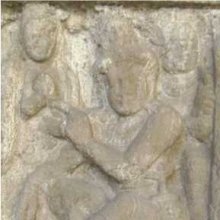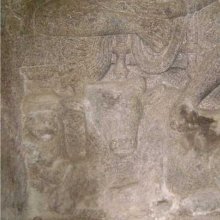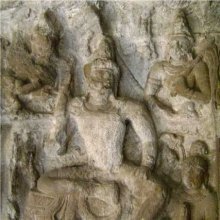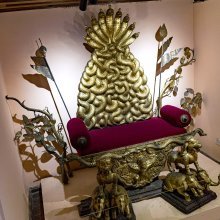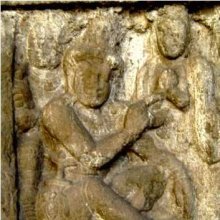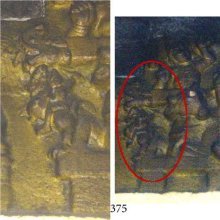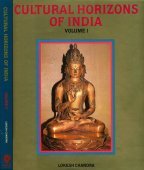Throne: 1 definition
Introduction:
Throne means something in the history of ancient India. If you want to know the exact meaning, history, etymology or English translation of this term then check out the descriptions on this page. Add your comment or reference to a book if you want to contribute to this summary article.
Images (photo gallery)
(+24 more images available)
India history and geography
Source: Singhi Jain Series: Ratnaprabha-suri’s Kuvalayamala-katha (history)Thrones (of kings) were commonly depicted on the Saṃsāracakra paintings (representing scenes of human life), in ancient India, as mentioned in the Kathās (narrative poems) such as Uddyotanasūri in his 8th-century Kuvalayamālā (a Prakrit Campū, similar to Kāvya poetry).—Page 185.21 f.: Here follows a description of a printed scroll illustrating the Jaina conception of saṃsāracakra. [...] The saṃsāra-cakra illustrated the three worlds of hell, human world and the world of gods. [For example:] A king seated on his throne and surrounded by his feudatories and feeding on five mouthfuls of food offered in a leafy cup by a woman.

The history of India traces the identification of countries, villages, towns and other regions of India, as well as mythology, zoology, royal dynasties, rulers, tribes, local festivities and traditions and regional languages. Ancient India enjoyed religious freedom and encourages the path of Dharma, a concept common to Buddhism, Hinduism, and Jainism.
See also (Relevant definitions)
Ends with: Lion throne, Royal throne.
Full-text (+1137): Simhasana, Bhadrasana, Nripasana, Rajasana, Dharmasana, Manca, Bhadrapitha, Simhasanastha, Indrashana, Rajyarohana, Totaya, Rajyabhisheka, Rajavasati, Parikshit, Caturaji, Yuvaraja, Shakrashana, Padmasana, Adigadi, Rajyabhishaka.
Relevant text
Search found 228 books and stories containing Throne; (plurals include: Thrones). You can also click to the full overview containing English textual excerpts. Below are direct links for the most relevant articles:
Manasara (English translation) (by Prasanna Kumar Acharya)
Chapter 45 - The thrones (siṃhāsana-lakṣaṇa)
Chapter 42 - The royal orders and insignia (rāja-lakṣaṇa)
Medaram Jatra < [April – June, 2002]
The Golden Master < [April – June, 1999]
Whims of the Gods < [March 1944]
Guhyagarbha Tantra (with Commentary) (by Gyurme Dorje)
Text 6.5 (Commentary) < [Chapter 6 (text and commentary)]
Text 1.5 (Commentary) < [Chapter 1 (text and commentary)]
Text 6.4 (Commentary) < [Chapter 6 (text and commentary)]
Trishashti Shalaka Purusha Caritra (by Helen M. Johnson)
Part 6: Birth-rites of Śreyāṃsa < [Chapter I - Śreyāṃsanāthacaritra]
Part 13: Conquest of the goddess Gaṅgā by Sagara < [Chapter IV - Conquest of Bharatavarṣa by Sagara]
Part 6: Conquest of Vaitāḍhya by Sagara < [Chapter IV - Conquest of Bharatavarṣa by Sagara]
Vimalakirti Nirdesa Sutra (by Robert A. F. Thurman)
Chapter 6 - The Inconceivable Liberation
Chapter 11 - Lesson of the Destructible and the Indestructible
The Great Chariot (by Longchenpa)
Part 3d.2a - The perfect place < [B. The explanation of the kayas and wisdoms]
Part 4a.2 - Meditating on the mandala < [B. The explanation of meditation practice, together with its action of ripening and freeing]
Part 3d.1 - Sambhogakaya: The brief teaching < [B. The explanation of the kayas and wisdoms]
Related products
